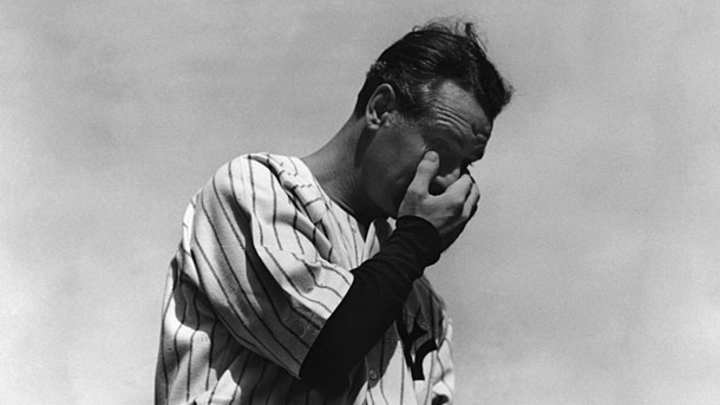Remembering Lou Gehrig on occasion of two notable anniversaries

Lou Gehrig's emotional farewell at Yankee Stadium came less than two years before he died of the disease that now bears his name. (AP)

More than seven decades after his passing, Lou Gehrig is still the standard by which so many are measured, whether they're elite first basemen, Yankee legends, uncannily durable athletes or lives cut tragically short. Thus it's worth pointing out a couple of anniversaries connected to "The Iron Horse."
On June 3, 1932, Gehrig, long since established as one of the game's elite players but nevertheless still playing in the shadow of Babe Ruth, did something that no major leaguer, not even his more famous teammate (who by that point was 37 years old), had done in the 20th century: hit four home runs in a single game. He homered off Philadelphia A's starter George Earnshaw in the first, fourth and fifth innings, then added another off reliever Roy Mahaffey in the seventh.
With the Yankees in the process of banging out 23 hits and 20 runs — not to mention a then-record 50 total bases in one game — that day at Shibe Park, Gehrig still had two more chances at bat. He grounded out against Rube Walberg in the seventh inning, but narrowly missed another homer in the ninth against Eddie Rommel when his drive to deep centerfield (dead center was 468 feet away from home plate) was caught by a leaping Al Simmons.
The shots came at almost exactly the halfway point of Gehrig's career output of 493 homers; they were his 241st, 242nd, 243d and 244th. Despite the outburst, Gehrig finished the season with "only" 34 homers, down from the previous year's league-leading total of 46; he did hit a fairly typical .349/.451/.621 and finished as runner-up to Jimmie Foxx, who hit 58 homers, in the AL MVP voting. He would go on to lead the AL in homers in 1934 and 1936 with 49 in each year, winning the traditional and slash-stat Triple Crowns in the earlier of those two seasons (.363/.465/.706 with 165 RBIs to boot) and his second AL MVP award in the later one (.354/.478/.696 with 152 RBIs).
On June 2, 1941, almost nine years to the day after that historic afternoon, Gehrig died at the age of 37 due to amyotrophic lateral sclerosis, the neurodegenerative disease that forced his retirement two years earlier after a streak of playing in 2,130 consecutive games. That record stood until 1995, when it was broken by Cal Ripken Jr.
Despite an early demise that limited him to 14 full seasons and small fragments of three others, Gehrig's body of work is still a thing to behold, starting with his .340/.447/.632 batting line; that on-base percentage ranks fifth all-time, the slugging percentage third. When he retired, his 493 homers ranked second in major league history behind only Ruth's 714; today it's still tied for 26th overall and third behind Ruth (659) and Mickey Mantle (536) among Yankees. Meanwhile, Gehrig is second in Yankee history with 2,721 hits, and first with 534 doubles, 163 triples and 1,992 RBIs. He helped the Yankees to seven pennants and six world championships, batting .361/.477/.731 with 10 homers in his World Series appearances.
